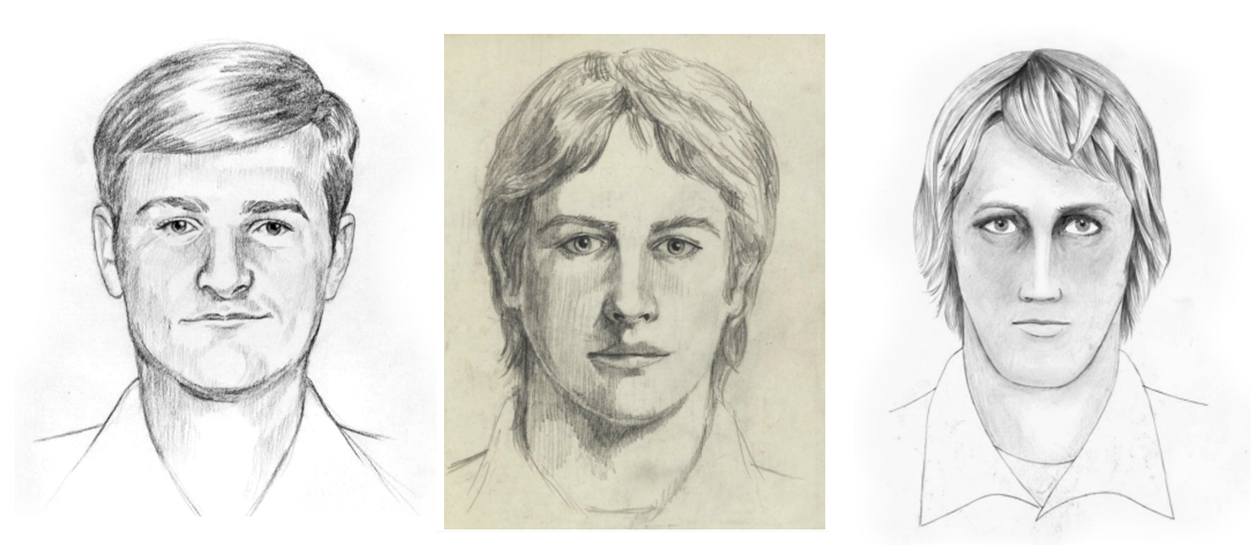Michelle McNamara's tantalizing roadmap for finding a long lost serial killer
Before she died, she was hunting for the Golden State Killer. Her posthumously published book asks readers to pick up where she left off.


The Golden State Killer could be the most horrifying of America's serial killers.
Not just because of his gruesome crimes, his disturbing chatter and hysterical weeping, or his penchant for collecting personal items from his victims while leaving behind valuables and cash. It is not even for the fact that he vanished without a trace after terrorizing California communities over the course of a decade between 1976 and 1986, raping more than 50 women in their own homes and murdering at least 10 people by bludgeoning them to death with items discovered nearby, like a log taken from a fireplace, or a pipe wrench.
The reason the Golden State Killer haunts the detectives who worked on his case, the families of victims and survivors, and the crime writers and amateur sleuths on his trail all these decades later is because it is unfathomable that he got away. Not just on principle — although, of course, such a monster should be brought to justice — but because of the abundance of evidence, the bounty of witnesses, and the sophistication of modern DNA technology used in the case. With all this, how could such a sadistic killer simply vanish into thin air?
The Week
Escape your echo chamber. Get the facts behind the news, plus analysis from multiple perspectives.

Sign up for The Week's Free Newsletters
From our morning news briefing to a weekly Good News Newsletter, get the best of The Week delivered directly to your inbox.
From our morning news briefing to a weekly Good News Newsletter, get the best of The Week delivered directly to your inbox.
As the late, brilliant true crime writer Michelle McNamara puts it in I'll Be Gone in the Dark, her posthumously published book about her own hunt for the killer: "There's a scream permanently lodged in my throat."
McNamara described herself as a true crime obsessive, a quality she traces back to a brutal murder near her home in Chicago when she was 14. That killer was never found. "I need to see his face," she writes of that first unknown murderer. "He loses his power when we know his face." It is the guiding principle behind her work, which seeks not to relish in the gory details of homicide or exploit the victims and their families for the sake of a scary story, but to take away the power of a killer by the simple fact of giving him a name.
McNamara's obsession with solving cold cases manifested as a popular blog, True Crime Diary, which aimed specifically to "find the angle others have overlooked — a suspect's revealing online activities, for instance, or a similarity between cases that hasn't been made public yet." Naturally, the Golden State Killer became her "white whale," the editors of I'll Be Gone in the Dark write.
Ever obsessed with the power of the name, McNamara coined the "Golden State Killer" moniker in a 2013 piece about her pursuit of his identity, published in Los Angeles Magazine; he is also known regionally as the East Area Rapist and the Original Night Stalker, or, when the two were found to be the same person using DNA, by their blended acronym "EAR/ONS." As McNamara notes in one True Crime Diary post, "The displeased felt that [the moniker] sounded too glamorous, like he was a Hollywood star," although she argues that it is nevertheless fitting: "His swath of violence extended from the state capital to the central coast to a planned community in Orange County."
A free daily email with the biggest news stories of the day – and the best features from TheWeek.com
The Golden State Killer is thought to have started out as a ransacker in Visalia, California, in the mid-1970s. He then moved up to Sacramento County, where he began breaking into single-story homes to rape women who were sleeping alone, having clearly memorized beforehand their schedules and habits: "He was always a stranger to you, but you were not to him," McNamara wrote in her Los Angeles Magazine piece. He would leave afterwards the same way he had come, melting back into the night, vaulting over neighborhood fences — "gone in the dark," as he put it threateningly to one victim.
The East Area Rapist, as he was known during this stint, then began targeting couples, waking them in the middle of the night and forcing the woman to tie up the man with pre-cut ligatures. He would take husbands into a separate room and stack dishes on their backs, warning that if the man made any moves to escape or help his wife — and the rapist heard the dishes fall — he would kill them both.
In Goleta in 1979, a foiled attack and a near capture made the East Area Rapist change his methods. "After that," McNamara writes in I'll Be Gone in the Dark, "none of his victims ever lived to describe him again." His last known murder, of Janelle Cruz in 1986, was almost exactly 10 years after his first known rape in Rancho Cordova in 1976.
Then ... nothing. Why did he stop? Did he die? Is he still alive? The questions are infuriating for their lack of answers, like a paperback thriller with the last pages torn out. "If you commit murder and then vanish, what you leave behind isn't just pain but absence, a supreme blankness that triumphs over everything else," McNamara writes.
So she began to look for what had been overlooked, becoming obsessed with the microscopic details of the case: What the killer's breathing sounded like ("loud, sucking inhalations"), what he took from his victims (driver's licenses, monogrammed cuff links), what could trigger his ego (after the media claimed he only raped women at home alone, he began to specifically target couples). "I scroll through the memories with the hope that something useful might reveal itself, a throwaway comment about an event, or job, that might connect back to something I've read elsewhere," she writes in one True Crime Diary post.
McNamara, though, was not greedy for the glory that would come with putting a face to such a notorious killer; she was collaborative by nature, winning over the respect of detectives on the case and meeting fellow internet sleuths to test and debunk competing theories. She had written about half of I'll Be Gone in the Dark when she died unexpectedly in her sleep at the age of 46 in 2016. "She thought she was getting real close to finding him," says true crime journalist Billy Jensen in CBS's Forty Eight Hours episode on the Golden State Killer. "And then she was gone."
I'll Be Gone in the Dark, painstakingly assembled by McNamara's editors and research partners from drafts and notes, serves not as a grand reveal of a killer's identity, but a tantalizing roadmap for other would-be sleuths — a sort of invitation to go down the same rabbit hole that she did. Its third section breaks from the rest of the book to "organize the materials Michelle left behind," including lists (items taken from victims, for example) and geo-profiles that triangulate the killer's possible area of residence during his sprees.
The most frustrating detail of all is that police have the Golden State Killer's DNA, but they can only compare it to DNA in their database of criminals convicted of felonies — where there are, naturally, no hits. There are other DNA databases in existence, though: 23andMe has 1.5 million people's profiles, and Ancestry.com has 2.5 million. "Unfortunately," write McNamara's editors, "neither company will work with law enforcement, citing privacy issues and their terms of service." Yet "[i]f we could just submit the killer's actual genetic material ... to one of these databases, the odds are great that we would find a second or third cousin and that person would lead investigators to the killer's identity. So the answer very well [could] be sitting behind this locked door."
If he is still alive, the Golden State Killer would be between the ages of about 60 and 75, the FBI estimates. Although it has been decades since his last known crime, he haunts headlines, podcasts, and true crime television series: He's still out there, threatens one recent trailer. The FBI continues to offer a $50,000 reward for information leading to his arrest.
McNamara did not miss the uncomfortable parallel in this obsession over the case, calling it an "uneasy realization I've had about how much our frenetic searching mirrors the compulsive behavior — the trampled flower beds, scratch marks on window screens, crank calls — of the one we seek." In notes collected by her editors, she likens herself to a rat searching for food and observes the adrenaline rush of the hunt. "He's the fake shark in Jaws," she writes, "barely seen so doubly feared."
McNamara's untimely death means she will never learn the identity of the Golden State Killer. Her legacy, though, is not tied to an answer to that question so much as it is to the pursuit of it. I'll Be Gone in the Dark exists as a plea to never accept not knowing — to keep turning over stones until one day all the masked killers are yanked into the light.
"[H]is power evaporates the moment we know him," McNamara writes. "We learn his banal secrets. We watch as he's led, shackled and sweaty, into a brightly lit courtroom as someone seated several feet higher peers down unsmiling, raps a gavel, and speaks, at long last, every syllable of his birth name."
Jeva Lange was the executive editor at TheWeek.com. She formerly served as The Week's deputy editor and culture critic. She is also a contributor to Screen Slate, and her writing has appeared in The New York Daily News, The Awl, Vice, and Gothamist, among other publications. Jeva lives in New York City. Follow her on Twitter.
-
 A peek inside Europe’s luxury new sleeper bus
A peek inside Europe’s luxury new sleeper busThe Week Recommends Overnight service with stops across Switzerland and the Netherlands promises a comfortable no-fly adventure
-
 A long weekend in Zürich
A long weekend in ZürichThe Week Recommends The vibrant Swiss city is far more than just a banking hub
-
 Late night hosts lightly try to square the GOP's Liz Cheney purge with its avowed hatred of 'cancel culture'
Late night hosts lightly try to square the GOP's Liz Cheney purge with its avowed hatred of 'cancel culture'Speed Read
-
 Late night hosts survey the creative ways America is encouraging COVID-19 vaccinations, cure 'Foxitis'
Late night hosts survey the creative ways America is encouraging COVID-19 vaccinations, cure 'Foxitis'Speed Read
-
 The Daily Show's Trevor Noah carefully steps through the Israel-Palestine minefield to an 'honest question'
The Daily Show's Trevor Noah carefully steps through the Israel-Palestine minefield to an 'honest question'Speed Read
-
 Late night hosts roast Medina Spirit's juicing scandal, 'cancel culture,' and Trump calling a horse a 'junky'
Late night hosts roast Medina Spirit's juicing scandal, 'cancel culture,' and Trump calling a horse a 'junky'Speed Read
-
 John Oliver tries to explain Black hair to fellow white people
John Oliver tries to explain Black hair to fellow white peopleSpeed Read
-
 Late night hosts explain the Trump GOP's Liz Cheney purge, mock Caitlyn Jenner's hangar pains
Late night hosts explain the Trump GOP's Liz Cheney purge, mock Caitlyn Jenner's hangar painsSpeed Read



